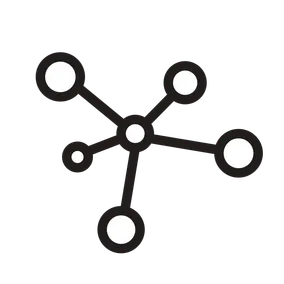“Friends” (Undirected Graph Connections) in Rails

Social relationships are tricky to model in a relational database. Here, we'll walk through an approach that is robust, easy to query, and avoids data duplication.
No, sorry, not THOSE friends. But if you're interested in how to do some graph stuff in a relational database, SMASH that play button and read on.
My current project is a social network of sorts, and includes the ability for users to connect with one another. I've built this functionality once or twice before, but I've never come up with a database implementation I was perfectly happy with. This type of relationship is perfect for a graph database, but we're using a relational database and introducing a second data store wouldn't be worth the overhead.
The most straightforward implementation would involve a join model (Connection or somesuch) with two foreign key columns pointed at the same table (users in our case). When you want to pull back a user's contacts, you'd have to query against both foreign keys, and then pull back the opposite key to retrieve the list. Alternately, you could store connections in both directions and hope that your application code always inserts the connections in pairs (spoiler: at some point, it won't).
But what if there was a better way? I stumbled on this article that talks through the problem in depth, and it led me down the path of using an SQL view and the UNION operator, and the result came together really nicely. Let's walk through it step-by-step.
First, we'll model the connection between two users:
class CreateConnections < ActiveRecord::Migration[6.1]
def change
create_table :connections do |t|
t.references :sender, null: false
t.references :receiver, null: false
t.timestamps
end
add_foreign_key :connections, :users, column: :sender_id, on_delete: :cascade
add_foreign_key :connections, :users, column: :receiver_id, on_delete: :cascade
add_index :connections,
"(ARRAY[least(sender_id, receiver_id), greatest(sender_id, receiver_id)])",
unique: true,
name: :connection_pair_uniq
end
endI chose to call the foreign keys sender and receiver, not that I particularly care who initiated the connection, but it seemed better than user_1 and user_2. Notice the index, which ensures that a sender/receiver pair is unique in both directions (so if a connection already exists where Alice is the sender and Bob is the receiver, we can't insert a connection where the roles are reversed). Apparently Rails has supported expression-based indices since version 5. Who knew!
With connections modeled in our database, let's set up the relationships between user and connection. In connection.rb:
belongs_to :sender, class_name: "User"
belongs_to :receiver, class_name: "User"
In user.rb:
has_many :sent_connections,
class_name: "Connection",
foreign_key: :sender_id
has_many :received_connections,
class_name: "Connection",
foreign_key: :receiver_id
Next, we'll turn to the Scenic gem to create a database view that normalizes sender/receiver into user/contact. Install the gem, then run rails generate scenic:model user_contacts. That'll create a file called db/views/user_contacts_v01.sql, where we'll put the following:
SELECT sender_id AS user_id, receiver_id AS contact_id
FROM connections
UNION
SELECT receiver_id AS user_id, sender_id AS contact_id
FROM connections;
Basically, we're using the UNION operator to merge two queries together (reversing sender and receiver), then making the result queryable via a virtual table called user_contacts.
Finally, we'll add the contact relationships. In user_contact.rb:
belongs_to :user
belongs_to :contact, class_name: "User"
And in user.rb, right below the sent_connections/received_connections stuff:
has_many :user_contacts
has_many :contacts, through: :user_contacts
And that's it! You'll probably want to write some validations and unit tests but I can't give away all my tricks (or all of my client's code).
Here's our friendship system in action:
[1] pry(main)> u1, u2 = User.first, User.last
=> [#<User id: 1 first_name: "Ross" …>, #<User id: 7 first_name: "Rachel" …>]
[2] pry(main)> u1.sent_connections.create(receiver: u2)
=> #<Connection:0x00007f813cde5f70
id: 1,
sender_id: 1,
receiver_id: 7>
[3] pry(main)> UserContact.all
=> [#<UserContact:0x00007f813ccbefc0 user_id: 7, contact_id: 1>,
#<UserContact:0x00007f813cca40f8 user_id: 1, contact_id: 7>]
[4] pry(main)> u1.contacts
=> [#<User id: 7 first_name: "Rachel" …>]
[5] pry(main)> u2.contacts
=> [#<User id: 1 first_name: "Ross" …>]
[6] pry(main)> # they're lobsters
[7] pry(main)>So there it is, a simple, easily queryable vertex/edge implementation in a vanilla Rails app. I hope you have a great day, week, month, and even year.
Network Diagram Vectors by Vecteezy
"I'll Be There for You" (Theme from Friends) © 1995 The Rembrandts
